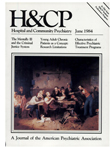Treatment Characteristics of Effective Psychiatric Programs
Abstract
As part of a large cooperative study undertaken by the Veterans Administration (VA) to identify the ward characteristics of effective psychiatric programs, 123 treatment characteristics were analyzed using four measures of patient posthospital community adjustment derived from the Veterans Adjustment Scale and the Personal Adjustment and Role Skills Scale. The authors found that wards that peformed best on the measures were characterized by staff who perceived less order and organization on the ward, nursing staffs with less shift rotations, a lower percentage of socially passive patients, a higher percentage of patients off the ward, a higher percentage of neurotic patients on no antipsychotic drugs at discharge, and lower dosages of the minor tranquilizers. These six treatment characteristics accounted for 29 percent of the variance in the outcome measures. After discussing the relationship of the findings from this study to the findings from a previous article on the VA study, which analyzed ward setting characteristics and program outcome, the authors conclude that ward programs differ in their effectiveness as measured by ratings of patient posthospital community adjustment and that both setting and treatment characteristics make a difference in that adjustment.
Access content
To read the fulltext, please use one of the options below to sign in or purchase access.- Personal login
- Institutional Login
- Sign in via OpenAthens
- Register for access
-
Please login/register if you wish to pair your device and check access availability.
Not a subscriber?
PsychiatryOnline subscription options offer access to the DSM-5 library, books, journals, CME, and patient resources. This all-in-one virtual library provides psychiatrists and mental health professionals with key resources for diagnosis, treatment, research, and professional development.
Need more help? PsychiatryOnline Customer Service may be reached by emailing [email protected] or by calling 800-368-5777 (in the U.S.) or 703-907-7322 (outside the U.S.).



